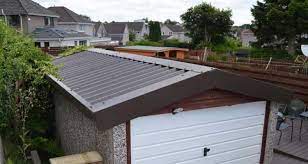Fixing a garage roof can seem like a daunting task, but with the right tools, materials, and knowledge, it can be a manageable project. There are several steps you can follow to repair or replace a garage roof, depending on the extent of the damage and your budget.
Assess the damage
The first step in fixing a garage roof is to assess the damage. If the damage is minor, such as a few missing or damaged shingles, you may be able to repair the roof yourself. If the damage is more extensive, such as widespread leaks or structural damage, you may need to hire a professional roofer or replace the entire roof.
Gather the necessary tools and materials
Before you begin any repairs, you’ll need to gather the necessary tools and materials. The tools you’ll need will depend on the type of repairs you’re making, but may include a hammer, roofing nails, roofing cement, a ladder, a pry bar, and a utility knife. The materials you’ll need will depend on the type of roof you have, but may include shingles, flashing, underlayment, and roofing felt.
Repair or replace damaged shingles
If the damage is limited to a few missing or damaged shingles, you may be able to repair the roof yourself. Start by removing any damaged shingles with a pry bar. Then, replace them with new shingles by sliding them under the existing shingles and nailing them in place. Be sure to use roofing cement to seal the edges of the new shingles.
Replace flashing
Flashing is the metal or plastic material that covers the seams where the roof meets other surfaces, such as a chimney or a vent pipe. If the flashing is damaged, it can cause leaks and other problems. To replace flashing, start by removing any damaged or corroded flashing with a pry bar. Then, cut a new piece of flashing to fit the area and secure it in place with roofing nails and roofing cement.
Repair leaks
If your garage roof is leaking, you’ll need to locate the source of the leak and repair it. Start by inspecting the roof for any obvious signs of damage, such as missing or damaged shingles or flashing. If you can’t locate the source of the leak, you may need to remove sections of the roof to inspect the underlying structure. Once you’ve located the source of the leak, repair it with roofing cement or by replacing any damaged materials.
Replace the entire roof
If the damage to your garage roof is extensive, or if your roof is old and in poor condition, you may need to replace the entire roof. This can be a costly and time-consuming process, but it can also add value to your home and provide better protection from the elements. To replace a garage roof, you’ll need to start by removing the existing roof, including any old shingles, underlayment, and roofing felt. Then, install new underlayment, roofing felt, and shingles, being sure to follow the manufacturer’s instructions and local building codes.
Maintain your garage roof
Once you’ve repaired or replaced your garage roof, it’s important to maintain it to prevent future damage. Regular maintenance can include inspecting your roof for damage, cleaning your gutters, and trimming any nearby trees that could damage your roof during a storm. You should also consider adding a layer of reflective coating to your roof to help reduce your energy costs and extend the life of your roof.
In conclusion, fixing a garage roof can be a challenging but rewarding task. Whether you’re repairing a few damaged shingles or replacing the entire roof, it’s important to take the time to assess the damage, gather the necessary tools and materials, and follow the manufacturer’s instructions and local building codes. By taking these steps, you can ensure that your garage roof is properly repaired or replaced, and that it will provide reliable protection for years to come.

